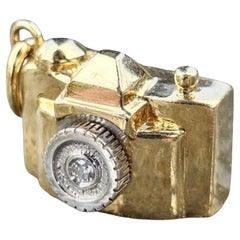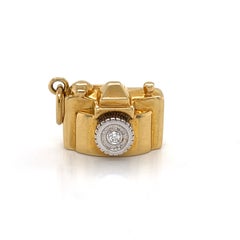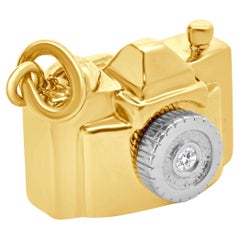Tiffany And Co Camera Charm
Late 20th Century Charm Bracelets
Diamond, 18k Gold, White Gold, Yellow Gold
Recent Sales
21st Century and Contemporary European Modern Charm Bracelets
Diamond, 18k Gold, Yellow Gold
21st Century and Contemporary Charm Bracelets
Diamond, 18k Gold, White Gold, Yellow Gold
1990s Modern Charm Bracelets
Diamond, Ruby, Blue Sapphire, 18k Gold, Yellow Gold, Platinum
The Legacy of Diamond in Jewelry Design
Antique diamond rings, diamond tiaras and dazzling vintage diamond earrings are on the wish lists of every lover of fine jewelry. And diamonds and diamond jewelry are primarily associated with storybook engagements and red-carpet grand entrances — indeed, this ultra-cherished gemstone has a dramatic history on its hands.
From “A Diamond Is Forever” to “Diamonds Are a Girl’s Best Friend,” pop culture has ingrained in our minds that diamonds are the most desired, the most lasting and the most valuable gemstone. But what makes the diamond so special? Each stone — whether it’s rubies, sapphires or another stone — is unique and important in its own right. April babies might claim diamonds for themselves, but just about everyone wants this kind of sparkle in their lives!
There are several factors that set diamonds apart from other stones, and these points are important to our gem education.
Diamonds are minerals. They are made up of almost entirely of carbon (carbon comprises 99.95 percent; the remainder consists of various trace elements). Diamonds are the hardest gemstones, ranking number 10 on the Mohs Hardness Scale. Even its name, diamond, is rooted in the Greek adamas, or unconquerable. The only object that can scratch a diamond is another diamond. Diamonds are formed deep within the earth at very high temperatures (1,652–2,372 degrees Fahrenheit at depths between 90 and 120 miles beneath the earth’s surface) and are carried up by volcanic activity. Diamonds are quite rare, according to the Gemological Institute of America, and only 30 percent of all the diamonds mined in the world are gem quality.
In the 1950s, the Gemological Institute of America developed the 4Cs grading system to classify diamonds: clarity, color, cut and carat weight. Not all diamonds are created equal (there are diamonds, and then there are diamonds). The value of the diamond depends on the clarity (flawless diamonds are very rare but a diamond's value decreases if there are many blemishes or inclusions), color (the less color the higher the grade), cut (how the diamond’s facets catch the light, certain cuts of diamonds show off the stone better than others) and carat weight (the bigger, the better).
When you start shopping for a diamond engagement ring, always prioritize the cut, which plays the largest role in the diamond's beauty (taking the time to clean your diamond ring at least every six months or so plays a role in maintaining said beauty). And on 1stDibs, a range of buying guides can be found for those in the market for antique engagement rings, vintage engagement rings or Art Deco engagement rings.
Shop antique and vintage diamond rings, diamond necklaces and other extraordinary diamond jewelry on 1stDibs.
Finding the Right Charm-bracelets for You
Vintage charm bracelets are a no-brainer when it comes to accessorizing. Modern charm bracelets feature a variety of charms and are made from a range of materials. And just as they did thousands of years ago, each charm on a charm bracelet today holds unique significance for the wearer and tells a piece of their story.
The charm bracelet, as a distinctive and personal finishing touch, has been around for a long time.
An iconic fashion statement, the charm bracelet has changed considerably throughout human history, but it has always been imbued with deep personal meaning. Jewelry in general has held intimate significance for us for thousands of years. Nearly every Egyptian, rich or poor, took jewelry seriously and was buried with some kind of jewels, and, later, jewelry of the Hellenistic era was passed down between generations as family heirlooms.
As children, we played with the antique and vintage bracelets that populated the jewelry boxes in our family homes, hearing them jingle and jangle while we learned the story of each charm. If we were lucky, some of our favorite charm bracelets were passed down to us as keepsakes.
Charm bracelets quickly became an extremely popular piece of jewelry in the 19th century. The Victorian penchant for symbolic jewelry lent itself perfectly to charm bracelets. Queen Victoria popularized charm bracelets among European nobility, as she was incredibly enthusiastic about giving them as gifts. Their popularity continued through her reign and into the 1900s. Tiffany & Co. introduced its iconic charm bracelet in 1889, and, since then, our love for this accessory has only broadened.
On 1stDibs, the collection of vintage charm bracelets for sale includes Cartier charm bracelets, Tiffany charm bracelets and more.


